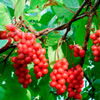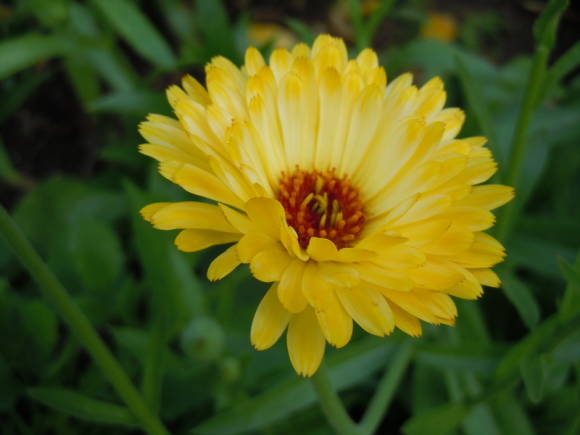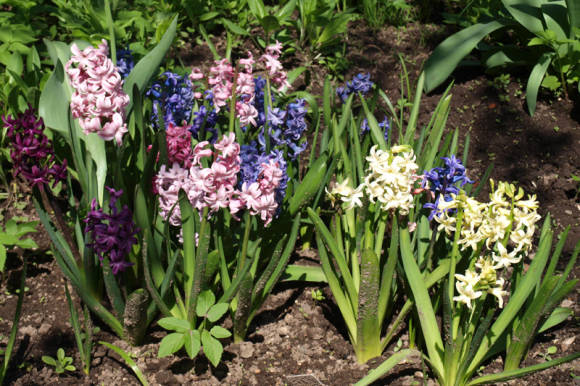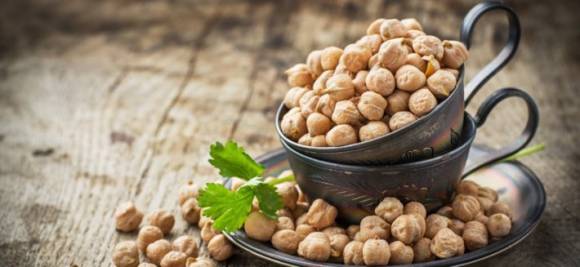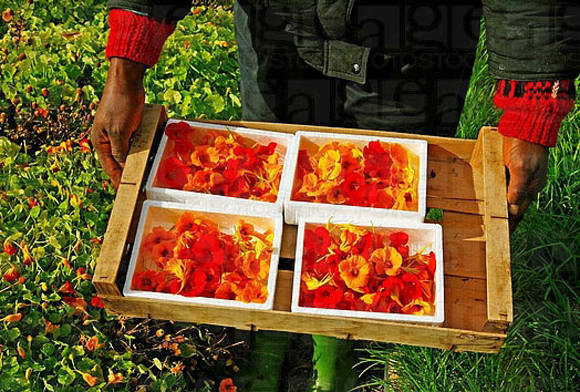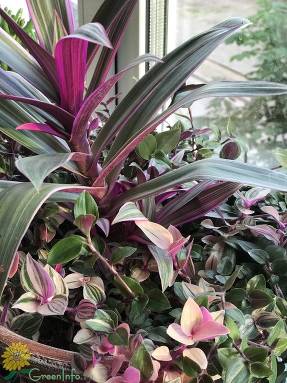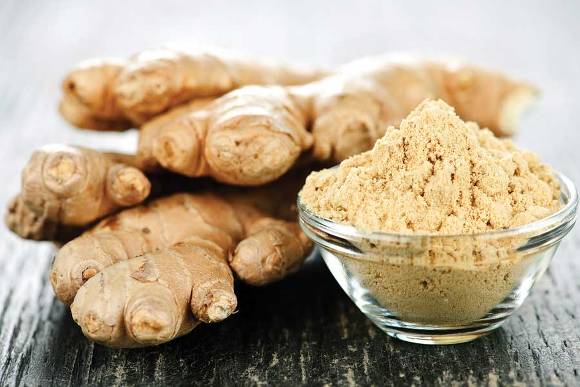
A seemingly inconspicuous perennial plant from the umbrella family grows in the grass cover of many historical garden and park complexes (Umbelliferae) - Sneak ordinary (Aegopodium podagraria). The Latin name of the genus comes from the Greek words aegos - "goat" and podion - "leg": petals have such a shape (like the footprint of a hoof), and the folk nicknames of this plant are snitka, snid, food-grass, borina, hogweed, daglitsa, yaglytsya , ger, gir, hava, rustle, idle time, sleep.
This is a plant with a horizontal creeping rhizome. Stem erect, furrowed, sometimes slightly pubescent, hollow, weakly branched, 50-100 cm high. Lower leaves on long petioles, twice trifoliate, leaves oblong-ovate, up to 8 cm long, sharply serrate along the edge, upper leaves on short petioles, smaller and less dissected. Leaf blades, pubescent on the underside. The inflorescence is a complex umbel, in which there are 300-500 small, white flowers with five almost heart-shaped petals. Fruits are oblong (3-4 mm), brown, ribbed. Blooms in June - July for about a month.
It is found in Europe and in the European part of Russia, as well as in the Caucasus, in Western and Eastern Siberia, Central Asia. Dreaming is widespread in the Non-Black Earth Region and on the Volga Upland. Forms extensive thickets in deciduous forests, in clearings, clearings, forest edges, floodplain meadows, in parks. In shady places, it grows wildly and often does not bloom for years. The minimum life span is about 50 years.
In gardens and vegetable gardens, it is a malicious, difficult to eradicate weed, although not devoid of beauty.

The Russian Museum and the Tretyakov Gallery contain two studies by the artist I.I. Shishkin dedicated to this plant. One of them is called "Dream-Grass".
The blooming specimen resembles a white cloud, which attracts bees and other insects with a sweet aroma throughout the day, but especially from 11 to 15 hours. Honey productivity is up to 230-240 kg / ha. In warm and humid weather during its flowering, the daily weight gain of the control hive is about 4 kg (for the entire period of honey collection - up to 40 kg). This is a strong argument in favor of preserving this species.
Full chemical composition with. ordinary is practically not studied. 100 g of leaves contain 65 - 100 mg of vitamin C and up to 8 mg of carotene, which is probably why they smell like carrots. The leaves contain protein (over 20%) and relatively little fiber. The amount of ascorbic acid increases by autumn. The mineral composition of the leaves is represented by a number of micro and macro elements.
Studying the snuff, we found a significant amount of potassium (up to 8.1%). It also contains Ca, Fe, Si, P, Mg, Al, Mo, V, Cu, Ga, B, Ti, Zn. So, in 100 g of fresh snow - 16.6 mg of iron, 1.99 mg of copper, 2.13 mg of manganese, 1.68 mg of titanium, 3.9 mg of boron. In the lipophilic fraction, the chlorophyll content was determined (1.6%; unsaturated and saturated fatty acids were identified: palmitic, stearic, etc.) Organic acids are present in the stems and leaves - malic and citric. The inflorescences contain carbohydrates such as glucose and fructose; phenolcarboxylic acids - chlorogenic and caffeic; flavonoids - quercetin, kaempferol, kaempferol diglycosides; choline. The content of essential oil in the aerial part of the plant is 0.14%.
Sleepy does not have a natural rest period, it has a forced autumn-winter break in the growing season. Under favorable conditions, it hibernates with green leaves, and grows all year round in places with warm, snowless winters. Fruits contain essential oil (0.04%) and other substances, ripen in July - August. The plant is self-seeding, the seeds germinate in May.
Only shade-tolerant plants grow in the grass cover of historical landscape gardening objects in the shade of trees, which create a pleasant green background.
We found that in the old manor parks of the Volga Upland, as a rule, local species of herbaceous plants, typical of broad-leaved forest plantations, predominate, for example, with. ordinary (17%) and stinging nettle (16%).
When restoring the ground cover in landscape parks, the problem often arises of what to do with the growing dullness, the fight against which turns out to be ineffective. Even the removal of the ground cover together with the rhizomes of the dreaming reduces its quantity only for a short period of time. When creating manor parks, as a rule, work was carried out to improve the hydrological regime in the territory, the introduction of organic fertilizers, sand on heavy loams, etc.
As a result of this, conditions arose that were conducive to the development of glum lime forests. Due to its shade tolerance, runny inhibits the growth of other herbs. It easily penetrates the park and grows, often prevailing in the ground cover. It turned out that many of the surviving and feral introduced species of such a cover grow best in garden complexes with a carpet of dreams.
They represent entire ecosystems. It is impossible to remove the water in old parks without damaging the plantings. Therefore, its communities should be preserved, forming a green or flowering carpet.
In old parks, paths framed with a dull look very impressive, which, moreover, perfectly sets off trees and shrubs, creates a velvety cover under them.

However, in sunny glades, with regular mowing, runny cannot compete with other lawn grasses and quickly retreats.
If, for some reason, you still need to get rid of the plant, you will have to repeatedly use special herbicides, for example, Roundup. Moreover, to combat flushing, an increased (twice or more) concentration of its working solution should be used. If there is a little sleep, then the drug can be applied to the leaves with a brush. When using a sprayer, it is best to put a wide plastic bottle with a cut-off bottom over its head. This allows you to treat only the weed without affecting the neighboring plants. Good results are obtained by injecting a small amount of the solution with a syringe into the stem. It is also effective to wet fresh sections with a working solution. If cereals and strawberries grow nearby, then it is better to use "Lontrel" to exterminate the dream, which will act purposefully.
Still, don't be in a hurry! After all, sleepy is not only very decorative, but also very useful. It belongs to pigment-forming plants, with its help fabrics are dyed green and yellow. In Ancient Russia with. common was used as a food plant. Her first spring seedlings helped our ancestors to enrich their diet. Then the expression arose: "I would live to dream!".
In the "Life of Elder Seraphim of Sarov, Hermit and Hermit," it is said that the Monk spent three years in continuous fasting and prayer, feeding on nothing but despondency. No wonder he called it "food", which means "food, delicious food." During the Great Patriotic War, Moscow catering workers went out of town in spring and summer to prepare the leaves of this extraordinary herb for the winter for the capital's canteens.
And now, snake can be successfully used in cooking, adding its fresh herbs to various dishes (soups, cabbage soup, okroshka, salads, borscht instead of cabbage). Following the example of our ancestors, it can be pickled, salted, fermented, dried and used as a kind of spice to give dishes a pleasant aroma.
See Green salad with leaves of gravilata and snyti, Siny sauerkraut, Salad from herbs "At the dacha", Green soup with desiccants and nettles, Soup "Roadside", Salad "Supervitamin".
Sleep is rich in pectin, which is important for metabolism and the fight against slagging in the body.In folk medicine, it is used for chronic constipation, obesity, as well as for the prevention of cancer. The use of the plant for the treatment of gout is evidenced by its Latin specific name. It has anti-inflammatory and analgesic effects. Scientific medicine uses gleam to treat joint diseases: rheumatism, arthritis, arthrosis.
As a rule, fresh or dried leaves and rhizomes are used.
Mention should be made of its fortifying, detoxifying, antihypoxic properties. Preparations based on this plant help to normalize metabolic processes, improve the general condition of the body. They are used for the prevention and elimination of hypovitaminosis, iron deficiency anemia.
Russian and Ukrainian scientists point to the prospects of using slime to reduce the general toxic effect of anticancer drugs. The plant is used in medical practice for edema, kidney and bladder diseases. In addition, the aboveground part of the plant contains a significant amount of potassium. We assume that the accumulation of potassium is a metabolic feature of the plant, since the amount of this element in the soil, where the studied plants grew, turned out to be small. Potassium salts are important for the prevention of hypokalemia, which often develops with diuretic drugs.
Sleep preparations, due to their anti-inflammatory, emollient, wound-healing properties, are used externally for exudative diathesis, wounds and bedsores, erysipelas, fungal skin lesions.
There is information about the sedative effect of sleepiness and its use in empirical medicine for neuroses. In cardiovascular diseases, the anticoagulant and antihypoxic properties of sleep can be very valuable.
It also finds application in diseases of the gastrointestinal tract, which is associated with its choleretic effect, the ability to normalize digestion processes. It is also used in homeopathy. It is a part of the complex food supplement "Seaweed - Optima", which is recommended for the prevention of cancer, normalization of the gastrointestinal tract.
When preparing dreams, it must be remembered that the aerial part, less often the roots, serves as a medicinal raw material. The herb is stored during flowering. First, the raw materials are kept in the open air, and then in a dryer at a temperature of 25-30 ° C. The roots are dug up after the flowering of the plant, washed in cold water and dried in the shade or under a canopy. Aboveground parts are stored in a sealed glass container, and the roots - in a wooden container for 1–2 years.
It is very important to note that the common runny can be confused with poisonous species, including cicuta, dog parsley, hemlock. In poisonous species, the stems are thicker, branched and tall (more than 1 m), often with a purple or violet tint, the leaves are much narrower than dreaming.
The hemlock roots smell like celery, hemlock has an unpleasant mouse smell, its inflorescences are much larger than those of S. ordinary, on the stalk of dog parsley there are thin stripes, and the leaves shining on the underside with a garlic smell.
